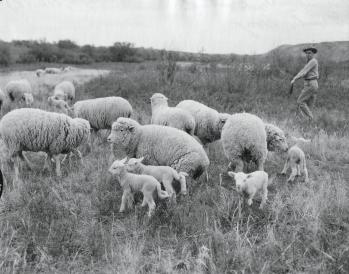
Sheep have been a part of Saskatchewan's economy for nearly 140 years, with the first sheep arriving on the Canadian prairies in the early 1800s. It has been noted that many of the large cattle ranches in southern Saskatchewan were actually established first as sheep operations. In 1889 the town of Maple Creek became a distribution point for 30,000 sheep that had been trailed across country from Idaho and Montana; these sheep comprised the fine wool range breeds. Ranchers felt they needed the hardiness, grazing habits and wool quality that they could obtain from the French Rambouillet and the Spanish Merino breeds, even though their conformation to produce meat left much to be desired. The largest flocks are still located in the southern part of the province; however, they only consist of 500-1,000 ewes and are now made up of the dual-purpose breeds: Targhee, Columbia, and other white-face crosses. The first sheep to arrive at the University of Saskatchewan sheep farm in 1911 were Shropshires. The sheep sector of the farm was quite dynamic during the first twenty years of its operation; various breeds were kept for judging and display purposes, but the Shropshire breed remained dominant for quite some time. Throughout the years many other sheep-breeding programs were undertaken and many research trials were conducted at the University of Saskatchewan.
The post-war period was not kind to the Saskatchewan sheep industry. Australia became the world supplier of fine wool; with synthetic fibres replacing wool in many types of clothing, the price of Canadian wool dropped; and the development of New Zealand as a major exporter of low-priced lamb affected the Canadian lamb market. Saskatchewan's sheep population has shifted with the changing times: its numbers peaked in 1934 at 381,000, and declined to below 100,000 head in 1974; an all-time low of 53,000 occurred in 1986. Since then sheep numbers have steadily risen, and the provincial ewe flock now stands at 70,000; this makes Saskatchewan the fourth-largest sheep producing province in the country.
Sheep production in this province consists of farm flocks, range flocks, and finishing operations; there is also some interest in dairy operations. There is a wide variety of breeds: Suffolk, Hampshire, Dorset, Columbia, Targhee, Rambouillet, North Country Cheviots, Canadian Arcotts, Rideau Arcotts, Texels, Katahdin and Dorper are the most common. Farm flocks range in size from sixty to 250 ewes, and generally market lambs that are fed to a finished weight of 110 pounds, the usual target weight for slaughter lamb in Canada. Range flocks are much larger and tend to be found grazing on short-grass prairie in the southwestern part of the province. These lambs are usually weaned off grass and sold as feeder lambs through the big fall sales, or direct to feedlots. There are several feedlot operations in the province, the largest being located north of Regina. Lamb makes its way to Canadian and American markets via order buyers, feedlots, and public auctions. Many lambs are sold through the assembly service of the Saskatchewan Sheep Development Board.
Sheep are often overlooked as an opportunity in agriculture, a factor that has been slowly addressed in recent years. Sheep production remains a viable alternative within sustainable agriculture: a relatively low cost of entry, a higher biological efficiency (more than one offspring), and additional opportunity areas such as wool and dairy make sheep production attractive. In addition, sheep provide a positive ecological grazing control where they are used to manage weeds such as leafy spurge and others found in emerging reseeded forests. With the advent of round bale feeders, portable electric fencing and many other labour-saving devices, more and more women are becoming the flock caretakers and managers. However, there are many challenges in producing sheep, including predator problems (coyotes) and the need to reach economies of size in order to supply markets on a continual basis.
The provincial industry is comprised of three associations which represent various subsectors, the largest of which is the Saskatchewan Sheep Development Board (SSDB). With its office in Saskatoon, it has the provincial mandate for industry development and is considered the voice of the industry; it also publishes the sheep industry's quarterly newsletter Sheep Shape. The Southern Saskatchewan Wool Growers Association was established in 1914, which makes it the oldest association still in existence. It was instrumental in the gathering and organizing of large shipments of wool. Currently there are five wool collection depots in the province, where the wool is transported to either the Canadian Co-operative Wool Growers in Carleton Place, Ontario, or to the wool depot in Lethbridge, Alberta. There are about twelve active shearers in Saskatchewan.
Purebred sheep production is represented by the Saskatchewan Sheep Breeders Association, which manages the purebred shows and sales in the province. Some of the other organizations that oversee the business of their breeds are the Saskatchewan Katahdin Association and the Western Katahdin Sheep Co-operative Ltd. The latest organization to be formed in the province is Canadian Prairie Lamb (CPL); incorporated in 2003, this group took the initiative to develop some value-added lamb products. Today CPL has a product line that includes raw and cooked marinated lamb kebabs, two varieties of cooked appetizer lamb meatballs, lamb sausage, and a product called “cooked lamb in Moroccan orange sauce.” CPL is leading the way in Canada when it comes to the processing and marketing of value-added lamb products.
Colleen Sawyer
Print EntryHOME | BROWSE BY SUBJECT | ENTRY LIST (A-Z) | IMAGE INDEX | CONTRIBUTOR INDEX | ABOUT THE ENCYCLOPEDIA | SPONSORS TERMS OF USE | COPYRIGHT © 2006 CANADIAN PLAINS RESEARCH CENTER, UNIVERSITY OF REGINA | POWERED BY MERCURY CMS |
|||
| This web site was produced with financial assistance provided by Western Economic Diversification Canada and the Government of Saskatchewan. |
|||
 |
 |
 |
 |
| Ce site Web a été conçu grâce à l'aide financière de Diversification de l'économie de l'Ouest Canada et le gouvernement de la Saskatchewan. |
|||